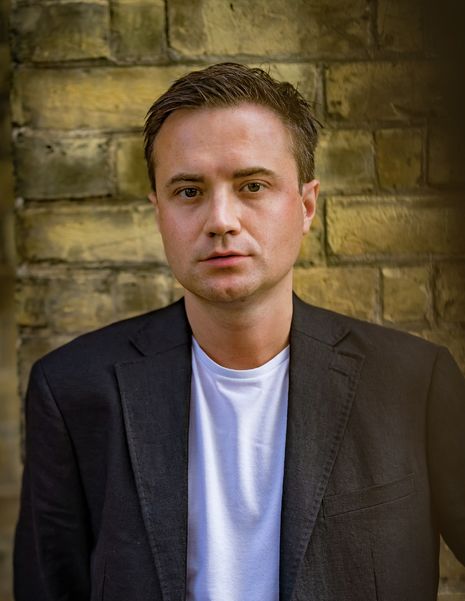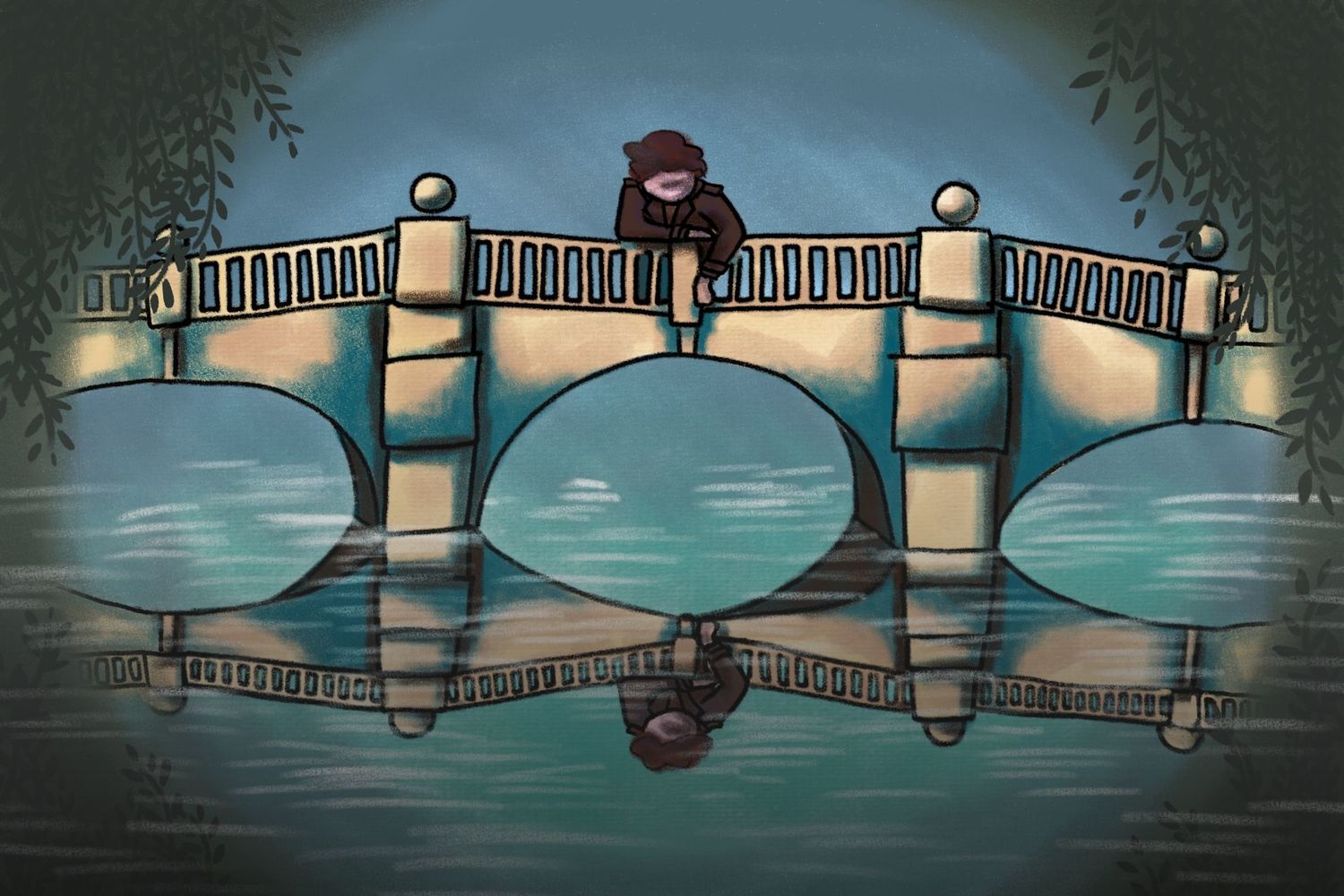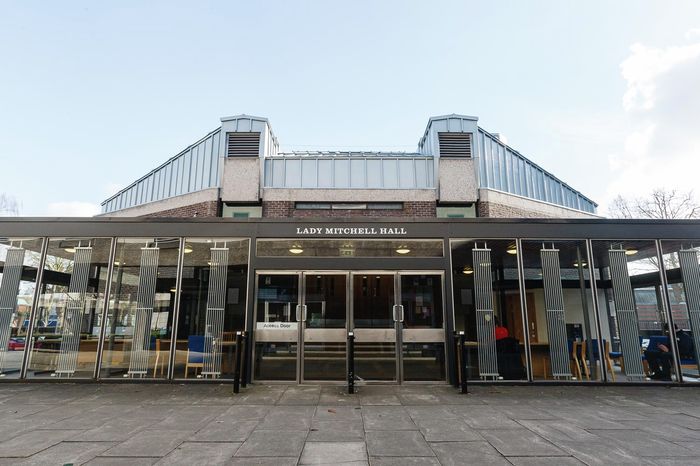I step on the train from Cambridge to King’s Cross, the same journey made by author James Cahill as he travelled to and from London while studying for a PhD here, and the same made by his protagonist, Don Lamb, when he is exiled to London from his haven in 1990s Peterhouse College. Leaving an environment as self-defining and suffocating as Cambridge can offer epiphany or downfall, or both.
The setting of Tiepolo Blue, Cahill’s debut novel, is fundamental, he tells me, as we sit in the plush coffee shop beneath Hotel Café Royal on Regent Street, where Cahill entertained clients of the art gallery he worked at years ago. Peterhouse in the 90s, in its resistance to the world and university both changing around it, represented a “hinge moment between the long 20th century and the moment we’re living in now, that end of history moment where it seemed like liberalism had triumphed and that the big polarities had been levelled”. Hiding out from all of this is the novel’s protagonist, Don Lamb. After arriving as an undergraduate he is quickly assimilated and, decades later, has rarely left, still living alone within the walls of the College. This aptly-named art history professor is looking backwards, toiling at his long-awaited study of Rococo painter Tiepolo, when his appalled reaction to a piece of modern art that appears on Peterhouse’s front lawn sees him suddenly cast out to the cold of South London and installed in a sinecure post at a small art gallery.
“Performance of the self can be something very authentic and necessary and essential”
“Something that I was interested in all the way through the novel is groupings, tribes, what it means to exist within a group of people, or to break outside of that group,” Cahill tells me. Peterhouse in the 90s was a perfect example of such a tribe: “Although they were very different from each other in many ways, they were united, and this is not my wording, I can’t remember who said this, like multiple spotlights converging on a hatred of liberalism.” Perhaps a belonging forged in hatred is bound to have brittle foundations; when Val, Don’s mentor (and something more besides), turns against him, Don is forced to face up to a self he isn’t sure he created.
Though Don “has been the victim of somebody else’s construction of him,” Cahill was careful to maintain that “he’s not just this passive cypher. He has knowingly accepted that and lived up to it.” Don isn’t blameless, and yet this isn’t only about blame: “I don’t think it’s always a matter of posturing. Performance of the self can also be something very authentic and necessary and essential.” The university environment is one which forces such a performance, and Cahill was aware of his literary heritage when conjuring it: “British campus novels were important in that evocation of an environment that envelopes and inevitably defines you, and that you very often will find yourself pushing back against.” Though Lucky Jim, for example, deals with “a person’s furious reaction against this world that they find closing in on them,” Don escapes from one such bind and into another, Cahill says: “When he goes and starts working at a museum and begins this new life, that in a way is just another prison that he has to be emancipated from.”
“Trying to form an identity for yourself in a world where everybody is posturing is really hard”
The novel’s relationship to the elite environments that trap Don is similar to that of its protagonist, caught between awe and disdain. Cahill admits that the book deals with “elite worlds, in terms of Cambridge, and then affluent South London and a small art museum,” but insists that it is not “a straight up celebration of those worlds”. Though he recognises their “allure,” the author is most interested in how “those worlds can inhibit or suffocate you, so to that extent you could call it a critique”. He later explains this duality: “It’s hard not to be seduced by the beauty of the environment but there are aspects to them which are difficult, to say the least, in terms of how exclusive or exclusionary they end up being.” But, if the novel is a critique, “it’s a fairly universal one: there isn’t a political point being made,” he admits: “I’m wary of any kind of novel that actively seeks to voice a critique; the critique, I think, is perhaps for the reader to feel and articulate in response to what they’ve read”. Later, Cahill tells me that he “never really” considers the reader’s response to his work: “That can’t really be my concern.”

As he is pushed from one intoxicating institution to another, somewhere within the pages of Tiepolo Blue is the real Don. As Cahill discusses the character, his sympathy for him and his search for identity is clear. Amid the exhilaration of entering Cambridge, or Oxford, where Cahill was an undergrad, a student must also feel, “speaking from experience, lost,” he says. He takes a long pause, as the clatter of teacups and whirrs of coffee machines presses in on our conversation: “There was also a lot of fear, a lot of insecurity - that thing of trying to form an identity for yourself in a world where everybody is posturing away, it’s really hard.” He admits: “I wouldn’t want to go back to being eighteen again now,” washing away the thought with a strained laugh.
The novel at its basis, Cahill tells me, is about “the pain of having to face yourself”. When the identity that was pressed upon Don, but which he had also clung to willingly, is torn away, he is forced to do something that “many of us don’t ever really have to do.” Though some readers have found the protagonist’s ignorance of his own sexuality, which emerges as his affected identity is stripped away, to be “frustratingly blinkered,” Cahill disagrees: “I know many scenarios where people will willfully ignore aspects of their life that they don’t want to face up to; it suits them not to see things that other people could see easily.”
“Academic institutions, and all sorts of institutions really, offer a form of protection”
But this moment of facing up to oneself is central for Cahill, one that is foreshadowed often throughout the narrative. I mention various moments when Don sees his own reflection, a mix of self-awareness and narcissism which is captured in the novel’s final, haunting image. Cahill recalls experiencing such moments himself: “Walking along a road, glancing at parked cars and seeing your own reflection swimming by. It’s a very strange, disorientating, dislocating experience to think: ‘That’s me. Is that what other people see when they see me? ’ And to hear oneself on one of these” - he reaches forward and gestures towards my phone where it lies on the table - “and think: ‘‘is that what I sound like? ’” The novel traces a process of accepting this “dislocation,” Cahill says, and “academic institutions, and all sorts of institutions really, offer a form of protection” from this painful experience, he says.
But the extremes of such an environment mean that, when Don is forced out, he achieves a radical freedom, a “painful epiphany”. As he comes to grips with his sexuality at a bracing speed, it becomes clear that there is no going back. “People who’ve been disappointed by the way the story ends, particularly people, I think, who feel you can’t do this to gay characters,” Cahill reflects, “have overlooked the fact that he has finally lived.” He insists: “I felt there could be no other possible ending.” I ask him: is Don’s end one of redemption or humiliation? “It’s both. That’s the point.”
James Cahill’s second novel, The Violet Hour, will be published in February 2025.


